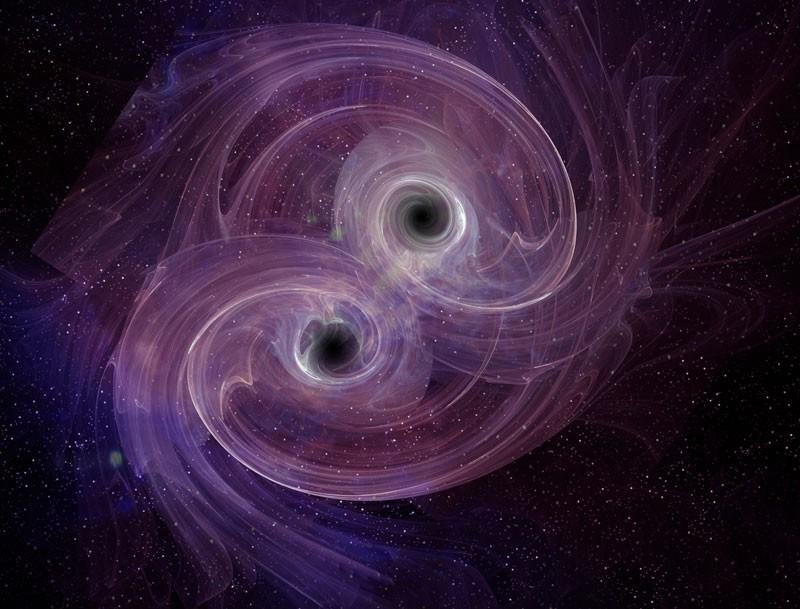every week, TecMundo and #AstroMiniBR brings together five relevant and entertaining astronomical curiosities produced by the world’s collaborators. profile on twitter to spread the knowledge of this science, which is the oldest!
#1: How strong is the merger of two black holes?
The first gravitational wave detection caught the merger of 2 black holes emitting 36 septillion yottawatts (3.6 × 104? watts), which is greater than the combined power of all the light emitted by all the stars in the observable universe.#AstroMiniBRpic.twitter.com/pC62DfjLo3
— Nicolas Oliveira (@nicooliveira_) 11 August 2022
What happens when two black holes collide? You don’t have to be an astronomy buff to imagine this is one of the most energetically powerful celestial events in the Universe.
When two massive black holes, each with the equivalent mass of dozens of suns, collide, what are known as gravitational waves are produced: oscillations in the fabric of space-time.
The first direct observation of gravitational waves was made by international collaborations LIGO and Virgo on September 14, 2015. Prior to this determination, gravitational waves were only indirectly inferred through their effect on the timing of pulsars in binary star systems. The pulse, detected by LIGO’s interferometers, recorded a gravitational wave originating from the merging process of a pair of black holes with approximately 36 and 29 solar masses, respectively.
The signal, named GW150914, was also the first observation of binary black hole merging and ushered in an entirely new era in the astronomical observation of extreme violent events in the Universe: This merger alone released more power than the entire light power of all stars. observable universe!
#2: How rare are the chemical elements that make up life on Earth?
“The chemistry that produced life can be easily reproduced in the cosmos. If there is no life outside Earth, the Universe is a huge waste of space.”
– Carl SaganWhat do you think?
Are we alone in the universe???# astrobiology #AstroMiniBR
[1/2] pic.twitter.com/3FBrdKIlMN– Patricia Cruz, PhD (@patyccruz2) August 12, 2022
When we think of the chemical elements that make up plants, animals, our bodies, and everything else, we are often taken to the source of most of these elements: the stars.
For example, with the exception of a few light atoms, such as hydrogen, which was forged in the early Universe just after the Big Bang, the absolute majority of chemical components were made in the cores of stars and in the final processes of the stars. billions of lives. years ago.
By mass, human cells are made up of 65% to 90% water, and a significant portion of the remainder is made up of carbon-based organic molecules. Thus, almost 99% of the mass of the human body consists of six elements: hydrogen (H), carbon (C), nitrogen (N), oxygen (O), calcium (Ca) and phosphorus (P) and almost 1% remaining potassium ( It consists of the elements K), sulfur (S), chlorine (Cl), sodium (Na) and magnesium (Mg). But these chemical elements are not rare in the Universe and are ubiquitous!
#3: Betelgeuse boom (but not what you might expect)
In 2019, the star Betelgeuse exploded several times the mass of the Moon – an explosion 400 billion times larger than typical emissions from our Sun!!#AstroMiniBR (c) NASA, ESA, Elizabeth Wheatley (STScI) pic.twitter.com/hLVkvg5bDm
— Thiago S Gonçalves (@thiagosgbr) 11 August 2022
Last Thursday (11), NASA published the results of its analysis of Betelgeuse’s behavior in 2019, which has attracted the interest of astronomers around the world.
Using data from the Hubble Space Telescope and several other ground-based observatories, astronomers concluded that the bright red supergiant star Betelgeuse exploded in 2019, but did not explode in a supernova: It lost a significant portion of its visible surface and caused a massive Ejection. Surface Mass (known by the abbreviation EMS) ejects 400 billion times more mass than an ordinary launch.
The cooled material cooled to form a dust cloud that made the star temporarily darker than Earth. This unprecedented stellar tumult interrupted the monster star’s 400-day wobble period, which astronomers had measured for more than 200 years.
Betelgeuse is slowly recovering from this disastrous spin with a still vibrating core. These results are important as they provide clues as to how red stars lose mass before exploding as supernovae at the end of their lives.
But the 2019 event doesn’t indicate that the star is about to explode anytime soon, as it could still take thousands of years for that to happen.
#4: The commonality between stars and dogs
What do dogs and stars have in common?
It is inversely proportional to its length. So, bigger stars live shorter lives!
Bigger ones seeing supernovas?#AstroMiniBR
(Dogs, on the other hand, should be immortal – if you disagree, you’re wrong) pic.twitter.com/MIAqmz5Q9x
— Camila Esperança (@astronomacamila) 8 August 2022
Just like man’s best friend, stars have a behavioral disposition in life: the bigger they are, the shorter they live. This is because a star’s lifetime is highly dependent on its mass. In general, the larger the star, the faster it burns its fuel source and therefore the shorter its lifetime. The most massive stars can burn up and explode into a supernova after just a few million years of merger.
Fortunately, offspring don’t explode in supernovas!
#5: How are galaxies classified?
galaxy morphology classification was created with objects for objects in our neighborhood.
?? spirals
?? ellipticals
?? lenticularhowever, contrary to expectations, we see that spiral galaxies formed more than 11 billion years ago.#AstroMiniBR
{c} Fudamoto+22 https://t.co/wxNquWguPt pic.twitter.com/YB73Rvcqbn— yanna martins franco (@martins_yanna) August 2, 2022
In astronomy beyond the limits of the Milky Way, it is very useful to use the morphological classification of galaxies: a system used by astronomers to group galaxies according to their visual appearance.
There are various schemes by which galaxies can be classified according to their morphology, the most famous being the Hubble sequence designed by Edwin Hubble in the 1920s.
According to Hubble’s classification, galaxies can be elliptical with uniform light distributions and appear as ellipses in images; spirals consisting of a flattened disk, a central concentration of stars known as a protuberance, known as a protuberance, where stars often form a spiral structure of two or more arms; and lenses consisting of a bright central bulge surrounded by a large disk-like structure, but without a visible spiral structure, unlike spiral galaxies.
Source: Tec Mundo
I am Bret Jackson, a professional journalist and author for Gadget Onus, where I specialize in writing about the gaming industry. With over 6 years of experience in my field, I have built up an extensive portfolio that ranges from reviews to interviews with top figures within the industry. My work has been featured on various news sites, providing readers with insightful analysis regarding the current state of gaming culture.













